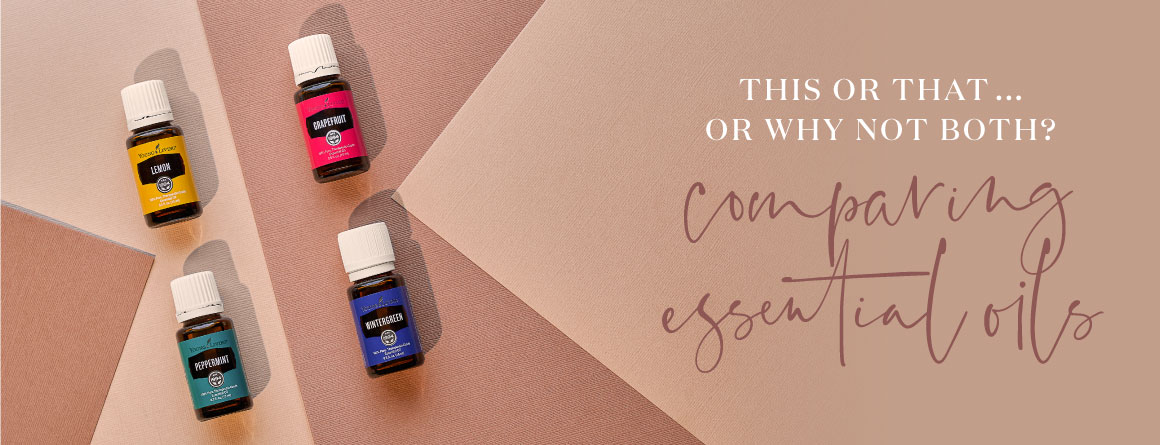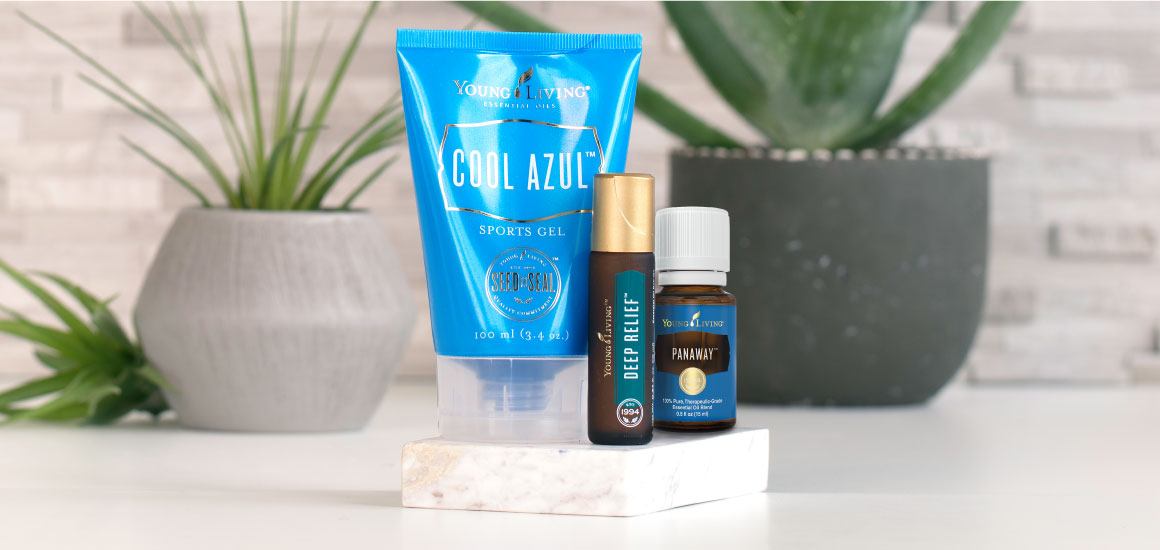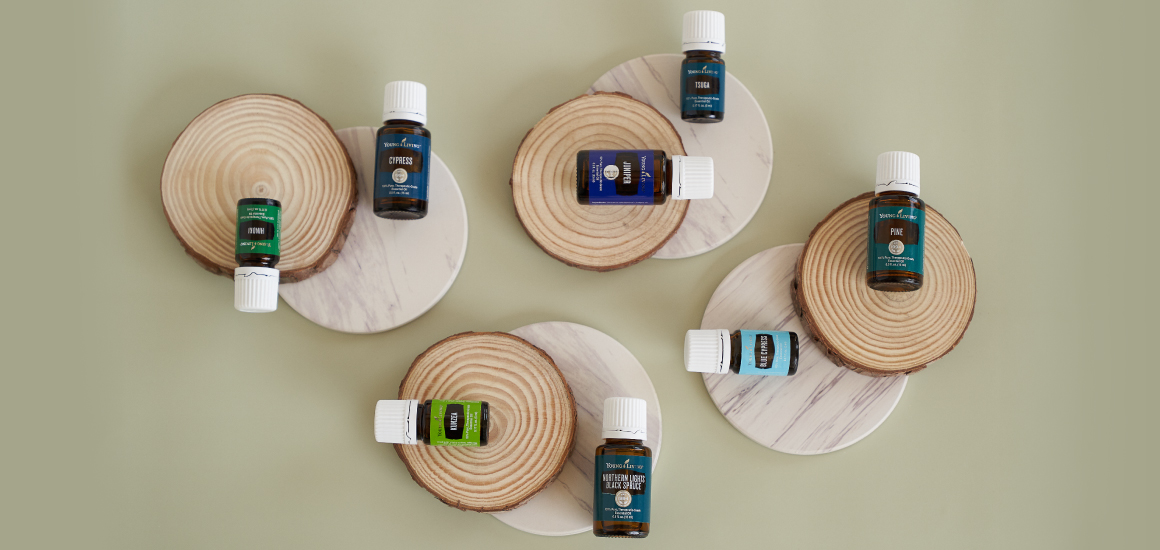Do you know the difference between Tea Tree and Australian Ericifolia? What about Cypress and Blue Cypress? Or Peppermint and Wintergreen? If these related essential oils have you scratching your head in confusion, then this post is for you!
Many classic pairs seem interchangeable on the surface. And while it’s true that you can use many of these oils in place of each other, they’re unique enough that you’ll want to keep both on hand. Use our infographic to help you pick a favorite from popular pairs or discover the benefits of a duo!

This comparison chart is only the tip of the iceberg when it comes to comparing essential oils. If you want to see an even better breakdown of each EO pair, dive deep with us below!
Tea Tree vs. Australian Ericifolia: How they’re different
Although they share the same genus, these two essential oils are entirely different species. A household staple, Tea Tree may be more well known, but Australian Ericifolia’s light, sweet scent is in a class of its own.
Tea Tree
Latin name: Melaleuca alternifolia
Aroma: Sharp and astringent
Perfect for: eliminating odors from extra-smelly places like garbage cans and gym bags
Also called: Melaleuca oil
Add to: homemade cleaners
Australian Ericifolia
Latin name: Melaleuca ericifolia
Aroma: Subtly clean with floral notes
Perfect for: revitalizing your spirit after a long day
Also called: Lavender Tea Tree
Add to: V-6™ Vegetable Oil Complex and rub into chest and shoulders
How they’re similar
Both Tea Tree and Australian Ericifolia fight musty odors with clean smells. They’re also cousins in the myrtaceae family.
Here’s how to use them:
- Freshen any space by diffusing.
- Get gorgeous, healthy-looking hair by adding a few drops to some carrier oil and massaging into your scalp.
- Add to your skin care routine to make blemishes less noticeable.
- Try these 17 usage tips with Tea Tree or swap in the gentler aroma of Australian Ericifolia.
Peppermint vs. Wintergreen: How they’re different
You can always rely on Peppermint to get the job done, but Wintergreen is a breath of fresh air in more ways than one! You may be surprised to learn that these oils aren’t related; in fact, wintergreen isn’t even a part of the mint family.
Peppermint
Latin name: Mentha piperita
Constituents: menthol, menthone, and menthofuran
Aroma: Refreshing and cool
Perfect for: keeping it fresh
Add to: LavaDerm™ After-Sun Spray for a chilly cooldown
Wintergreen
Latin name: Gaultheria procumbens
Constituent: methyl salicylate
Aroma: Sweet and shivery
Perfect for: Staying cool
Add to: thick foot cream for a tingly massage
How they’re similar
Though Wintergreen and Peppermint aren’t family members, they have a similar minty-fresh scent! Use either when you’re in need of a little refresh-mint.
Here’s how to use them:
Lemon vs. Grapefruit: How they’re different
Lemon’s aroma is all business, while Grapefruit’s aroma has a hint of playfulness. But which one is more a-peeling to you? Read on to discover the difference between these citrus essential oils.
Lemon
Latin name: Citrus limon
Constituents: linalyl acetate, linalool, and ocimene
Aroma: clean and tangy
Perfect for: removing sticky residue from adhesives
Add to: baking soda and water for a quick DIY cleaning scrub
Grapefruit
Latin name: Citrus paradisi
Constituents: sabinene, limonene, and nootkatone
Aroma: sweet and bright
Perfect for: creating a DIY exfoliating salt scrub
Add to: car vent diffuser for cheerier commutes
How they’re similar
Lemon and Grapefruit are sweet and tangy, just like the citrus fruits they come from. They’re also photosensitive, so remember to use them out of the sun!* Pair their light, bright scents with almost any other oil.
Here’s how to use them:
- Add to your nighttime face cleanser for an extra glow.
- Use in Thieves DIY cleaners for a bright scent.
- Make your own perfume or body spray.
Cypress vs. Blue Cypress: How they’re different
Cypress and blue cypress are both evergreens, but the two trees have very different genes. Because of this, the oils are more different than you might think. See why you want both Cypress and Blue Cypress in your collection.
Cypress
Latin name: Cupressus sempervirens
Origin: the leaves, nuts, and stem of the Mediterranean cypress tree
Constituents: alpha-pinene, limonene, and delta-3 carene
Aroma: Energetic and bright
Perfect for: Adding to shampoo for a burst of evergreen freshness
Blue Cypress
Latin name: Callitris intratropica
Origin: the wood of the blue cypress tree that is native to Australia
Constituents: guaiol, alpha-eudesmol, beta-eudesmol, and gamma-eudesmol
Aroma: Woodsy with a touch of lemony sweetness
Perfect for: Boosting the moisturizing effect of your favorite hand lotion
How they’re similar
When you’re pining for a forest-fresh scent, you can’t go wrong with either EO. Both Blue Cypress and Cypress smell like a stroll in the woods and add an invigorating aroma to massage, especially after a workout.
Here’s how to use them:
- Mix with face wash for an energizing, wake-you-up scent.
- Take your senses on a tour with our National forests diffuser blends.
- Make a DIY surface cleaner with ½ cup vinegar, 1 cup water, and 15–20 drops of essential oil.
Idaho Blue Spruce vs. Northern Lights Black Spruce: How they’re different
For a pleasing, peace-promoting scent, Idaho Blue Spruce is the way to go. But with an aroma as bright as the aurora borealis, Northern Lights Black Spruce nearly steals the show.
Idaho Blue Spruce
Latin name: Picea pungens
Origin: St. Marie’s Lavender Farm and Distillery in Idaho, USA
Constituents: alpha-pinene and limonene
Perfect for: adding to aftershave
Also found in: Shutran® essential oil blend
Northern Lights Black Spruce
Latin name: Picea mariana
Origin: Northern Lights Fort Nelson in British Columbia, Canada
Constituents: alpha-pinene, camphene, and beta-pinene
Perfect for: rubbing into the bottoms of your feet
Also found in: White Angelica™ essential oil blend
How they’re similar
Both come from Young Living-owned farms, so you can be confident that they’re good-quality, pure essential oils. The trees they are distilled from are also closely related cousins.
Here’s how to use them:
- Add to massage oil and rub into shoulders, feet, and back.
- Diffuse with Cedarwood and Lime for a chilly coastal blend.
- Combine them with other woodsy oils for a warm, fresh scent.
- Add a drop to hair oil and smooth over hair to tame flyaways.
Frankincense vs. Sacred Frankincense: How they’re different
No single oil is perfect for every task, but Frankincense sure comes close! As one of the most popular essential oils, it’s used for everything from yoga to skin care, whereas Sacred Frankincense™ is more commonly used for meditation and prayer.
Frankincense
Latin name: Boswellia carterii
Origin: Somalia
Aroma: earthy and deep with a hint of woodiness
Perfect for: trying resin burning—a different way to experience the wonder of Frankincense
Add to: an uplifting foot bath
Sacred Frankincense
Latin name: Boswellia sacra
Origin: Oman
Aroma: rich and sweet
Perfect for: creating grounding diffuser blends with Lemon
Add to: bathwater for a relaxing and tranquil soak
How they’re similar
Because Frankincense and Sacred Frankincense have the same constituents—alpha-pinene, limonene, and sabinene—you can use them in many of the same ways. Diffuse either one to increase your sense of spiritual awareness, grounding, and purpose.
Here’s how to use them:
- Diffuse during meditation or spiritual study.
- Wear a drop on your wrist or chest before beginning your yoga practice.
- Mix with moisturizer to reduce the appearance of uneven skin tone.
- Add 8–10 drops to 1 cup of Epsom salt for a tranquil bath
Want to learn the differences between other essential oils like Lavender, Thieves®, and Eucalyptus Radiata? Check out this cheat sheet!







Leave A Comment